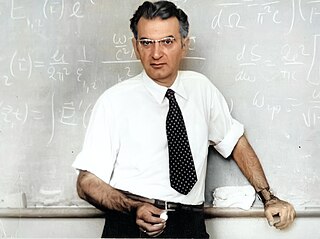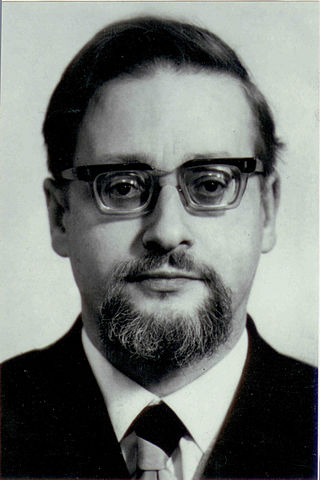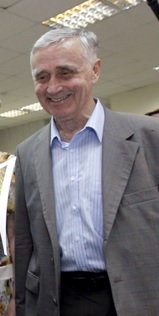
The Institute for Theoretical and Experimental Physics is a multi-disciplinary research center located in Moscow, Russia. ITEP carries out research in the fields of theoretical and mathematical physics, astrophysics, high energy particle physics, nuclear physics, plasma physics, solid state physics, nanotechnology, reactor and accelerator physics, medical physics, and computer science. ITEP also maintains an extensive educational program and organizes physics schools for scholars and undergraduates. The institute is located near the corner of the Sevastopol prospect and the Nachimowski prospect and occupies part of the former estate "Cheryomushki-Znamenskoye" - an 18th-century manor that is a monument of architecture and landscape art of the 18th-19th centuries.
Revaz Dogonadze was a notable Georgian scientist, Corresponding Member of the Georgian National Academy of Sciences (GNAS) (1982), Doctor of Physical & Mathematical Sciences (1966), Professor (1972), one of the founders of Quantum electrochemistry,

The Lebedev Physical Institute of the Russian Academy of Sciences, situated in Moscow, is a Russian research institute specializing in physics. The institute was established in its present shape in 1934 by academician Sergey Vavilov. It moved to Moscow and was named after a Russian physicist Pyotr Lebedev the same year. It is also known as P. N. Lebedev Institute of Physics or just Lebedev Institute. In Russian it is often referred to by the acronym FIAN (ФИАН) standing for "Physical Institute of the Academy of Sciences". The range of the research activities includes: laser technology, dark matter structure, nanostructures, superconductivity, cosmic rays, and gamma-astronomy. The institute developed a technique of crystallizing cubic zirconia.

The Joint Institute for Nuclear Research, in Dubna, Moscow Oblast, Russia, is an international research center for nuclear sciences, with 5500 staff members including 1200 researchers holding over 1000 Ph.Ds from eighteen countries. Most scientists are scientists of Russian Federation.
Oscar Sala, Italian-Brazilian nuclear physicist and important scientific leader, Emeritus Professor of the Institute of Physics, University of São Paulo.

The National Academy of Sciences of Ukraine is a self-governing state-funded organization in Ukraine that is the main center of development of science and technology by coordinating a system of research institutes in the country. It is the main research oriented organization along with the five other academies in Ukraine specialized in various scientific disciplines. NAS Ukraine consists of numerous departments, sections, research institutes, scientific centers and various other supporting scientific organizations.

Yatenko Leonid is a Ukrainian physicist, professor, Doctor of Science, Director of The Institute of Physics of the National Academy of Science of Ukraine, Academician of the National Academy of Sciences of Ukraine, Head of the National Research Foundation of Ukraine.

Hu Ning was a Chinese physicist and writer.
Aleksandr Ilyich Akhiezer was a Soviet and Ukrainian theoretical physicist, known for contributions to numerous branches of theoretical physics, including quantum electrodynamics, nuclear physics, solid state physics, quantum field theory, and the theory of plasma. He was the brother of the mathematician Naum Akhiezer.

Borys Viktorovych Grynyov is a Ukrainian scientist, public figure, member of the National Academy of Sciences of Ukraine (NAS), Honored Science Worker of Ukraine, Doctor of Engineering Science, Professor and currently Director of the State Fund for Fundamental Research of Ukraine. Chief Researcher of Institute for Scintillation Materials NAS of Ukraine

Gregory Markari (Markarovich) Garibian was a Soviet Armenian physicist, academician-secretary of the Department of Physics and Mathematics of the Armenian Academy of Sciences (AS)(1973–1991). He is known for developing the Theory of Transition Radiation and showing the feasibility of functional transition radiation detectors (TRDs). [8] [9]

Yuri Andreevich Yappa was a Soviet and Russian theoretical physicist. He is known for publications on particle physics, quantum field theory, General Relativity, philosophy of science, and for his graduate texts on classical electrodynamics and theory of spinors.

Volodymyr Zinoviiovych Turkevych is a scientist in the field of study of the physicochemical aspects of the superhard materials synthesis under high pressures and temperatures, the study of the thermodynamics and kinetics crystallization of diamond and cubic boron nitride at high pressures and temperatures, thermophysical instruments development. Doctor of Science (1996), professor (2011), corresponding member of National Academy of Sciences of Ukraine (2009).
Nikolay Sergeevich Dikansky — is a Russian/Soviet physicist, a scientist in the fields of accelerator physics and particle accelerators, the head of the laboratory in Budker Institute of Nuclear Physics, since 2011 academician of Russian Academy of Sciences, the chancellor of Novosibirsk State University.

Eduard Alekseevich Kuraev — Soviet and Russian theoretical physicist. Doctor of Physical and Mathematical Sciences (1971).

The School of Physics and Technology is one of the four physics schools of the V. N. Karazin Kharkiv National University. It specializes in the fields of theoretical physics, nuclear physics, plasma physics, materials science and medical physics. Distinctive features of the school include close cooperation with the Kharkiv Institute of Physics and Technology, and fundamental theoretical training in style of the Landau school, to which many instructors of the faculty belong.

Volodymyr Koshmanenko — Ukrainian mathematician, Doctor of Science, professor, Leading Researcher of the Institute of Mathematics of the NAS of Ukraine.

Alexander Nikolayevich Skrinsky is a Russian nuclear physicist.

Andrei Viktorovich Gaponov-Grekhov was a Russian (Soviet) physicist, a Full Member of the USSR Academy of Sciences, the founder of the Institute of Applied Physics in Nizhny Novgorod, and its first director in 1976-2003.















